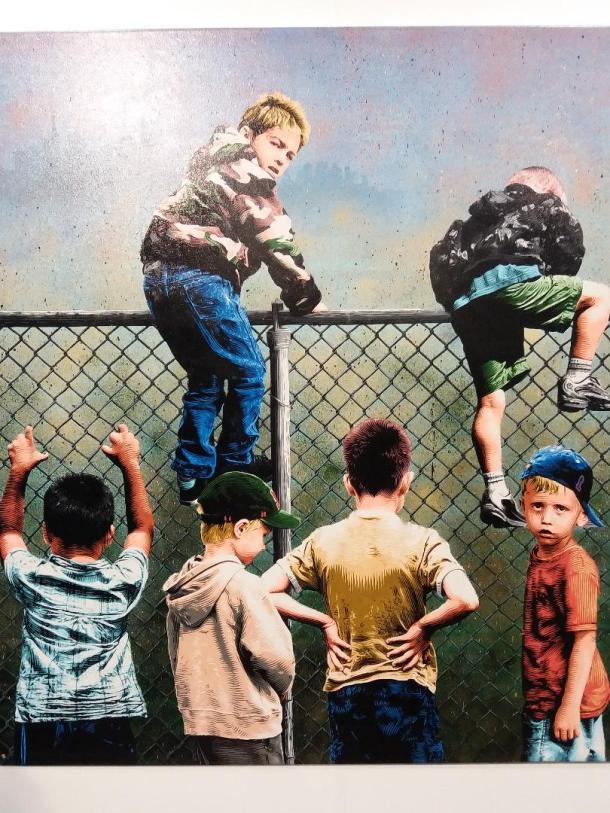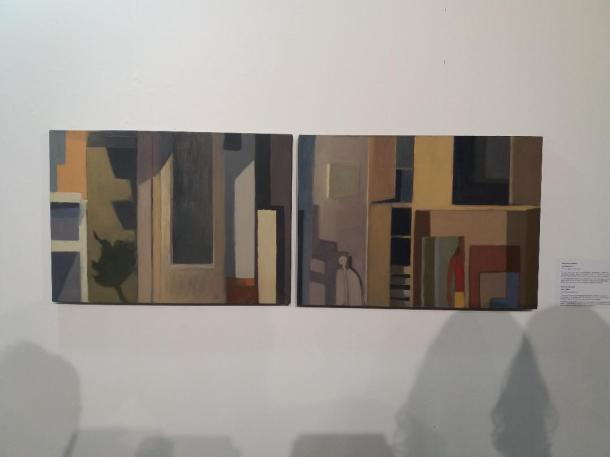
Work by Sonke
‘Polis, Flows, Tensions’ is an exhibition that comprises the works of 30 contemporary artists, who work in different mediums and styles, but who all have dealt with the concept of contemporary urbanity/urbanism and how it has been shaped today. The life, behaviour/nature of modern-day city-dwellers and their relationships are explored. Patterns are found in everyday scenes or in human movement, ancient Greek mythological characters are also discovered in the heart of the city. Of course refugees have become part and parcel of the city today, especially in Athens – and there is an empathetic focus on this subject too. The exhibition is part of the larger programme of events ‘Contested Cities – Athens 2017’, being hosted at the Cacoyiannis Foundation, which explore ‘Ancient Drama and Urbanism’ this year.
When reading the poem by Saad Abdllah, that is included in the ‘Polis’ exhibition, you see Athens, from the eyes of a stranger – the perspective of a Syrian refugee. A person infatuated with the city’s conundrums and paradoxes, the antitheses between a glorious antiquity and today’s hardships. This refugee-poet, once an archaeology student at Aleppo University, who has won a scholarship to study in the United States, is currently in limbo, in Athens. But his experience of the city has been inspiring, so inspiring that he told me he wants to write many more poems about Athens. Saad described the Greek people as having a ‘white heart’ – an Arabic expression which means that they have a pure, sweet heart. He also connected with Greece because like his own homeland, Syria, it is a ‘very old country’.

Saad Abdllah (first from left), with artist Maria Sevastaki (second from right), in front of her art installation and Saad’s poem.
Like many refugees, Saad arrived in Greece by crossing from Turkey to Samos about a year ago. He also spent time in the Samos Refugee camp . “It’s a famous island, we knew about it before we came – the museums, its ancient history, Hera’s temple, Pythagoras. I have been living in Athens for a month now. I want to write about Athens – one poem is not enough, because Athens is a real city. Many cities might have made a name for themselves, but they are not real the way Athens is. If I were to write about my experience of Athens, I would have to write many books, many poems.”, explains the young Syrian, who is also trying to make Greece a safe destination point for LGBT individuals from Arab countries, and is involved in the Light Spot group set up for this purpose. “Greece is the door for these people” he explains.
In Arab countries, LGBT people’s lives are in danger, something which Saad has experienced at first hand. Executions, beatings, death from stoning, being thrown off roof tops are just some of the ‘punishments’ faced. You can read all of Saad’s poem on Athens here.
Saad’s poem was right next door to a mixed media installation by Maria Sevastaki, an artist who has been living in Samos, Karlovasi, since 1996, and has also been involved with the refugee crisis there. I caught up with her in order to talk about her work in the show, and about her own art project ‘Big Blue Research’ on Samos:

Work by STMTS
– Tell us the story behind the work ‘Visual Chapters’ you are showing in the ‘Polis’ exhibition and how it evolved.
– The ‘Chapters’ are inspired from ‘The Forgotten’ – a poem by Miltos Sahtouris of 2012. But also by the experience of social dislocation and a rapidly growing biased and decaying Greek state experienced by my former husband refugee, art activist Sofiane Ait Chalalet and I. Between 2008-16, we experienced a hostile stance from the authorities of Samos. Also, the diary I kept during my hospital days, following a car accident, has also played a role. So, in short, chapters of my life inspired this work. I talk to the world through pictures. Due to being personally involved with the refugees, I have lived many tragedies – repeated daily in the Aegean sea – because European leaders refuse to give ‘safe passage’ to them. Each photo, artwork, video is a chapter in this fine art installation. Merideth Monk’s music came to mind whilst creating it, so I included that too. It is an installation that includes unknown refugee artworks, photos, documents, text, and the video abstractions from our work with the refugees on Samos. It was made with the aim to inspire human values and pride.

‘Visual Chapters’, mixed media installation by Maria Sevastaki
– How about the poet Saad Abdllah, how did you get to meet him and decide to include his poem?
Chris Jones – a sociologist from Samos Refugees – introduced me to Saad’s poem. This is how we met. Saad’s poem is alive and contributes positively to the ‘Polis’ initiative. My ‘Chapters’ is an ‘open’, evolving work, so I included it. We had a deadline for the exhibition at the Cacoyannis foundation, and I had submitted my work earlier. If we had met earlier with Saad, surely something different would’ve been arranged. I forwarded the poem to the foundation and the curator suggested that Saad reads it or have someone perform the poem on the opening night. Saad was shy. We hadn’t much time and decided to center the poem between my work ‘Visual Chapter: The Oepidups Cycle’ and ‘Establishments’, part of the series ‘Urban diaries 2016/7’, by Nikos Christoforakis. A fusion of genres in motion… The first time I met Saad in person, was at the Cacoyannis foundation on the opening night, when we placed the poem on the wall together. (You can read about Saad’s story: https://samoschronicles.wordpress.com/2017/07/).

work by Aphrodite Krontiri
– You moved to Greece from Australia. You are also a student of the Athens School of Fine Arts. Tell us about these chapters of your life.
– I was a student at the art school a long time ago. I studied painting and set design. Just after my studies I worked on theatrical sets with Vasilis Sakis having formally met him when serving as art director for swatch watch in Athens. After obtaining distinctions for my studies, I was sent off as a representative of the art school to the Algerian Biennale, and to the 2nd International Fine Arts Meeting of Delphi, 25 – 28 August (European Cultural Centre, Delphi. ‘Art in Modern Society ’ during 1989/90). We moved to Greece from Australia with my mother and brother at the end of 1971, and left again all together (plus an extra family member) in 1974. I came back to Greece at the end of 1981. In 1984, I was in a car accident. I was immobilized and couldn’t walk for many years. That’s when I decided to study painting and theatre design. The sounds of a dripping ceiling, and stains were an endless subject in my work. While I spent 6 ½ months in bed, in hospital, I drew sounds, abstractions and portraits of the women next to me who were preparing for the other life. At that time, I was also reading ‘The Oedipus Cycle‘ by Sophocles and other ancient Greek theatrical plays. Everything connects.
– What is Big Blue Contemporary Arts Research about?
– The research for ‘Big Blue’ started long before I was aware of it. After 2 ½ months in NYC when I turned down the gallery contract that got me there I decided to move, live and work on Samos. Back in 1984 I had met Piet Termaat in Samos – a pioneering Dutch sculptor, land artist and performer. He had rented an old ‘kafeneio’ in Ambelos village as a studio and summer home. He inspired an art research lab on Samos. Unfortunately he is no longer with us. When I was a student I couldn’t wait for the summer in order to go to Samos and meet up with him. He taught me many things. Big Blue Contemporary Arts was conceived when he was still in life, in 2010. In 2011 he passed away along with other friends that year. ‘Big Blue Contemporary arts experiment 1: Heterotopia: Art and the built environment’ was dedicated to Piet and our other friends. Big Blue is about me documenting facts of time in contemporary art.
– What’s it like to be an artist living in Karlovasi, Samos?
Lonely.

Work by Katerina Aslanidou
—————————————————————————————————————————————
- Participating artists in the ‘Polis, Flows, Tensions’ exhibition:
Katerina Aslanidou, Kelly Vardaka, Stratis Voyiatzis, Thalassini Douma, Polina Zioga, Maro Kouri, Natasa Kotsambasi, Konstantinos Koukoulis, Aphrodite Krontiri (Ende Neu), Thekla Malamou, Andreas Maratos, Nektarios Marinos, Eleni Mouzakiti, Kostas Bombos, Ismini Bonatsou, Nikos Papadimitriou, Aphrodite Papadouli, Maria Pastra, Alexandra Salimba, Maria Sevastaki, Angele Svoronou, Fivos Sofikitis, Alaxandra Stravoravdi, Sonke, STMTS (Stamatis Mitsios), Dimitris Taxis, Martha Tsiara, Utonom (Utn), Nikos Christofakis, Thodoris Chrysikos.
– Runs till September 30 at the Cacoyannis Foundation (206 Pireos St, tel 210-341-8550, http://www.mcf.gr). Open Mon-Fri 6pm-10pm, Sat-Sun 11am-2pm. Free entrance.